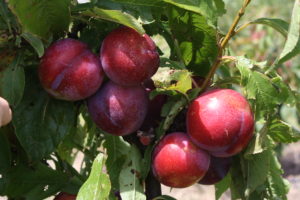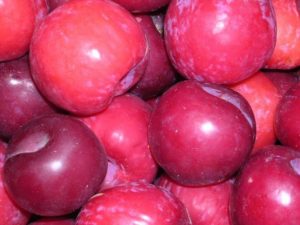General information:-
Plum plants are extensively oriented, limited, as well as require minimum care compared to almost all fruits plants. Plum is full of Vitamin A, B, (Thiamine), riboflavin along with nutrients such as calcium, phosphorus as well as iron. The properly merged acidity with sugar is beneficial in the processing of jams as well as squashes. The dry plums are best known prunes. The prunes possess excellent Ayurveda remedial significance. Liquid made from the prunes is beneficial in treating jaundice as well as summer bite.
Climate:-
Season
Temperature
20-30°C
Season
Rainfall
200-300mm
Season
Sowing Temperature
25-30°C
Season
Harvesting Temperature
20-25°C

Soil:-
Plum develops on an array of soils, deep fertile as well as properly drained, loamy land with a pH of 5.5-6.5. The land must be clear of hard pan, water logging as well as extreme salts.
Popular varieties with yield:-
Alubokhara: The plant is erect and also dispersing. The berries are of bigger in dimension compared to other cultivars. The yield is significantly less compared to Kala Amritsari. The epicarp is yellowish in shade with reddish patches. Pulp is luscious and sweetened.
Satluj Purple: This is a self-unfruitful cultivar also needs Kala Amritsari as being pollinizer. Kala Amritsari plum needs to be established like alternating plant in other rows for attaining decent fruits. The berry is of average in dimensions that weigh 25-30g. The epicarp is dense as well as mesocarp yellowish tinted firm body. The berries are generally consumed fresh. It ripens in initial May as well as produce 35-40 Kg of fruits per tree.
Kala Amritsari: It is best favored cultivar of plains. Berries are of average dimension, rounded oblate. The epicarp on ripening changes darkish purple. The mesocarp is yellowish in tint with succulent pulp. Fruits are minor acidic in flavor. Berry ripens in 2nd half of May. The fruits are renowned for producing Jam as well as squash.
Titron: This variety is a self-fruitful cultivar however the yield raises in case Alucha variety is utilized as a pollinizer. Titron variety is not bigger than Kala Amritsari. The berry size is not as big as Satluj Purple as well as kala Amritsari. The epicarp is thin compared to Kala Amritsari. The flesh is yellow-colored as well as little juicy. Fruits produce 30-35 Kg/ tree.
Kataruchak: The cultivar was founded in small town Kataruchak of Gurdaspur region in Punjab. The fruits trade overpriced compared to those Kala Amritsari, because of the availability of white bloom on the flesh of fruit. The berry is large in dimensions, heart designed as well as purplish in shade. It ripens soon after Kala Amritsari. Fruits produce 45-50 kg/tree. Berry is perfect for jam as well as squash preparation.
Land preparation:-
Do ploughing, cross ploughing of land and then levelled the land. Prepare land in such way that water stagnation should not occurred in field.
Sowing:-
Time of sowing:
Planting is done in first fortnight of January.
Spacing:
The ideal spacing of plum plant is 15cm X 30cm. The tree should be planted 6m X 6m apart from row and between plants.
Method of sowing:
Direct sowing of seedlings.
Seed:
Seed Rate:
The plum seed accommodates 110 tree/acre.
Propagation:-
Plums could be propagated efficiently on peach, plum with apricot rootstocks. For light ground area usage of peach rootstock is advisable, while for heavy garden soil, plum Kabul Green Gage cuttings and apricot rootstocks provide good outcome. Planted cuttings of Kala Amritsari are helpful straight away without budding. To do this, stem-cuttings are ready in the 1st week of December and after callusing around 30 days it is raised in area from 15cm x 30cm in January.
Fertilizer:
Fertilizer Requirement (kg/acre)
Tree age(in years)
FYM(kg/tree)
UREA(gm/tree)
SSP(gm/tree)
MOP(gm/tree)
1-2 years 6-12 60-120 95-120 60-120
3-4 years 18-24 180-240 285-380 180-240
5 and above years 30-36 300-360 475-570 300-360
When the tree is 1-2 years old, apply FYM@6-12 kg/tree, UREA@60-120gm/tree, SSP@95-120gm/tree and MOP@60-120gm/tree. When the tree is 3-4 years old, apply FYM@18-24kg/tree, UREA@180-240gm/tree, SSP@95-120gm/tree and MOP@180-240gm/tree. When the trees is 5 years and above, apply FYM@30-36 kg/tree, UREA@300-360gm/tree, SSP@475-570gm/tree and MOP@300-360gm/tree.

Weed control:
Fertilizer Requirement (kg/acre)
Tree age(in years)
FYM(kg/tree)
UREA(gm/tree)
SSP(gm/tree)
MOP(gm/tree)
1-2 years 6-12 60-120 95-120 60-120
3-4 years 18-24 180-240 285-380 180-240
5 and above years 30-36 300-360 475-570 300-360
When the tree is 1-2 years old, apply FYM@6-12 kg/tree, UREA@60-120gm/tree, SSP@95-120gm/tree and MOP@60-120gm/tree. When the tree is 3-4 years old, apply FYM@18-24kg/tree, UREA@180-240gm/tree, SSP@95-120gm/tree and MOP@180-240gm/tree. When the trees is 5 years and above, apply FYM@30-36 kg/tree, UREA@300-360gm/tree, SSP@475-570gm/tree and MOP@300-360gm/tree.
Irrigation:-
Plums are irregular rooted as well as rapid maturing thus requires adequate moisture throughout developing period. Time period of irrigation might rely on numerous aspects like soil variety, weather as well as type of major fruit trees. Regular irrigation at per week timeframe could be utilized in April, May as well as June. Hardly any irrigation is provided at complete blossom phase and ripening phase is provided to prevent flower. Throughout rainy climate no irrigation is needed. The timeframe might rise to twenty days in September, October as well as November.
plant protection:-
Brown Rot (fungus)
Disease and their control:
Brown rot (fungus): - Fruits have brown powdery masses. Fruits shrivel and form ‘mummies’.
Control: Keep trees well pruned to encourage air circulation. Remove and destroy dropped fruit. Spray with sulfur at pre-blossom stage repeat when shucks split, then weekly for 2 week.
Black knot (fungus): - Smoky black knots (galls) on twigs and limbs, which range in size from 1 to 30cm.
Control: Plant resistant cultivars, such as ‘president’ and ‘shiro’. Prune off galls. Make sure to cut at least 10cm below swellings.
Pest and their control:-
Plum curculios (weevil): - Small crescent shaped scars on fruit, which drop easily.
Control: - Pick up fallen fruits frequently. Once petals start to fall, each day spread a sheet below the tree and hit the tree trunk with a padded stick; collect and destroy the curculios that fall onto the sheet. Continue for 3 week.
Leaf-curl plum aphids: - Leaves and young shoots are twisted and stunted. Tiny, sticky insects are present.
Control: - Carefully timed sprays of horticultural oil will kill these aphids as they hatch. Or, apply neem when aphids are seen on leaves.
Harvesting:-
The maturity of plum fruit varies depending on the different types of variety. Plum must ripen fully on tree. The ripe fruit are used in several pickings and are packed with proper care.
Post harvest:-
Due to highly perishable character of plum it needs to be packed properly and are stored in proper temperature as they are chilling sensitive.
References:-
1.Punjab Agricultural University Ludhiana
2.Department of Agriculture
3.Indian Agricultural Research Instittute, New Delhi
4.Indian Institute of Wheat and Barley Research
5.Ministry of Agriculture & Farmers Welfare
